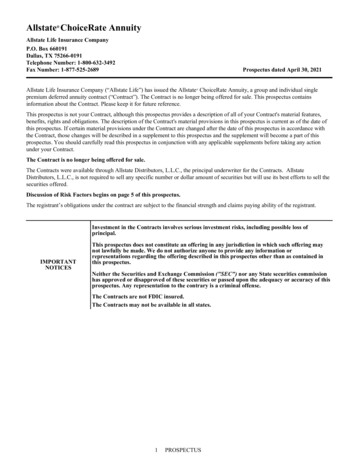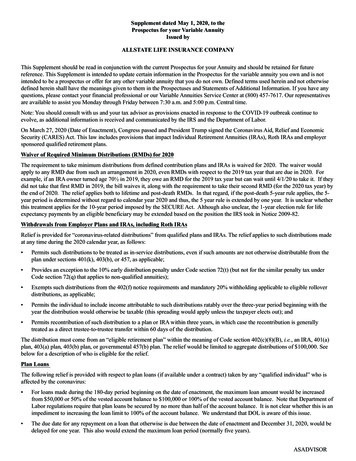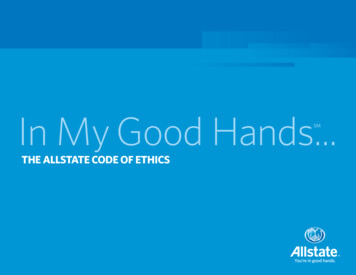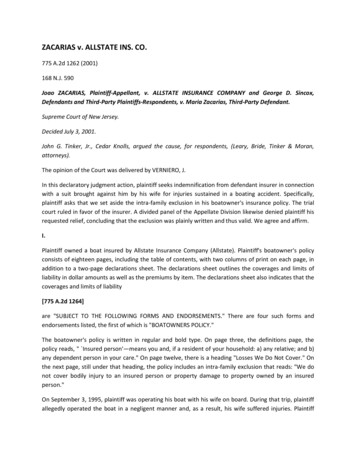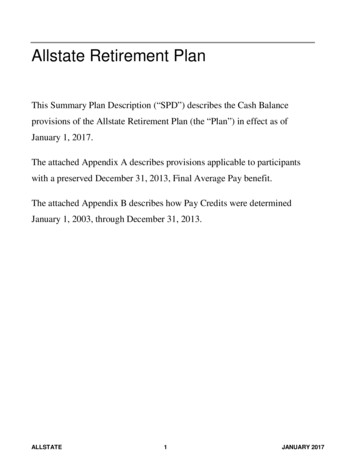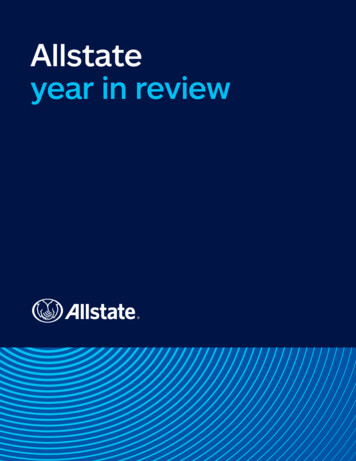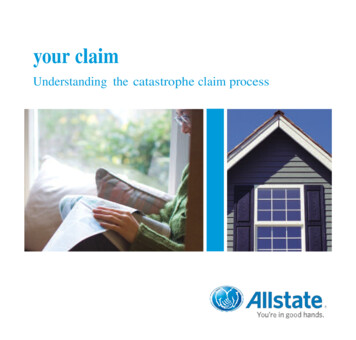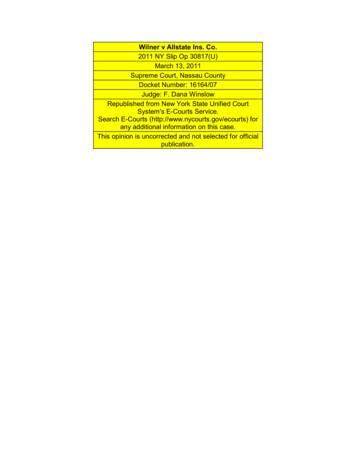
Transcription
Wilner v Allstate Ins. Co.2011 NY Slip Op 30817(U)March 13, 2011Supreme Court, Nassau CountyDocket Number: 16164/07Judge: F. Dana WinslowRepublished from New York State Unified CourtSystem's E-Courts Service.Search E-Courts (http://www.nycourts.gov/ecourts) forany additional information on this case.This opinion is uncorrected and not selected for officialpublication.
,. . . . . . . . . . . . .[* 1]SHORT FORM ORDERSUPREME COURT - STATE OF NEW YORKPresent:HON. F. DANA WINSLOW,JusticeTRIALIIAS, PART 4NASSAU COUNTYHARRY WILNER and JUDITH WILNER,Plaintiffs,-againstALLSTATE INSURANCE COMPANY,MOTION DATE: 10/10/10MOTION SEQ. NO. : 003, 004INDEX NO. : 16164/07Defendant.The following papers having been considered on the motion (numbered 1-4):Order to Show Cause.Notice of Cross Motion. . .Reply Affirmation and Affirmation in Oppositionto Plaintiff's Motion for Summary Judgment. Reply Affirmation ofSuzanne M. Saia.Allstate s Memorandum of Law in Support Of Motion toRea rgu e.Memorandum of Law in Support of Plaintiff's Cross- MotionAnd in Opposition to Allstate Insurance CompanyJudgment.Motion for SummaryReply Memorandum of Law in Further Support ofPlaintiff's Cross- Motion for Partial SummaryJ u dgm en t. . . . . CMotion by defendant ALLSTATE INSURANCE COMPANY (Seq. 003), and cross-summarmotion by plaintiffs HARRY WILNER and JUDITH WILNER (Seq. 004), for3212 , are determined as follows. In the interest ofjudgment pursuant toconsistency and economy, the Court has adjoured the motions for one month so that itmay decide concurrently all ten motions pending in four separate actions arising out thesame events.CPLRThis is an action brought by homeowners HARRY WILNER and JUDITH) forWILNER (" Plaintiffs ) against ALLSTATE INSURANCE COMPANY (" Defendant"349 in connectionalleged breach of contract and violation ofGeneral Business Law
[* 2]Allstate Deluxe PlusHomeowner s Policy (the "Policy ). For a complete recitation of the facts and proceduralhistory in this action , reference is made to the prior order of this Court , dated December2008 (the " December 2008 Order ), in which the Court dismissed Plaintiffs ' second' crosscause of action , sustained Plaintiffs ' third cause of action , and granted Plaintiffsmotion for discovery, as provided therein. The December 2008 Order also resolved (inaccordance with a conference held on December 12 2008) the matters upon whichDefendant was seeking reargument in the current motion. Defendant fied an appeal ofthe December 2008 Order , and on January 12 2010 , the Second Deparment affirmed somuch of the December 2008 Order as was the subject of the appeal.with Defendant's disclaimer of insurance coverage under PlaintiffsThe motion and cross-motion now before this Court seek summary judgment onthe first cause of action for breach of contract , which turs on the question of whether ornot Plaintiffs are entitled to insurance coverage for propert damage arising out of a stormevent that occurred in October of2005. The essential facts are undisputed. Plaintiffs are). Thethe owners of propert located at 6 Verity Lane , Roslyn , NY (the "Propert"Propert and contiguous properties are burdened by a storm sewer drainage easement infavor of the Vilage ofRoslyn (the "Vilage ). On or about October 7 2005 throughOctober 8 or 9, 2005, a heavy rainstorm occurred , resulting in an overflow of water froma clogged sewer drain manhole located on contiguous propert uphil of the Propert.The concentrated flow of water from the clogged manhole caused the soil in the rear ofPlaintiffs ' propert to slide downhil , and resulted in the destruction of Plaintiffsretaining wall , uprooting of several trees , and damage both to the Plaintiffs ' propert andAffidavit of Joseph V. Palmieri , sworn to on October 30,, and Exhibits thereto (Attached to Order to Show Cause); Report of PalMar2008Engineering, dated April 30 , 2007 (Exhibit I to Cross- Motion).the propert of the Vilage.SeePlaintiffs asserted a first-part claim under the Policy for the damage to theirretaining wall (Claim Number 5381643898). By letter dated October 27 2005Defendant disclaimed coverage on the basis that" (w Je do not cover loss or damageresulting directly or indirectly from Earth movement of any type , including, but notlimited to earthquake , volcanic eruption , landslide, subsidence , mudflow , pressuresinkhole , erosion or the sinking, rising, shifting, creeping, expanding, bulging, crackline2006 , Plaintiffs ' counsel issuedsettlng or contracting of the earth. " On or about July 24a request to Defendant for reconsideration of the disclaimer based upon the argument thatthe Policy s earh movement exclusion did not apply to the loss. Communicationsbetween the parties followed , and on December 21 , 2006 , an engineering firm hired byDefendant was sent to Plaintiffs ' home to determine the cause and extent of the damage tothe retaining wall. The report of PalMar Engineering, P. C. dated April 30 , 2007 (thePalMar Report" ) opined that the damage to the retaining wall was caused by the flow of
[* 3]2005. " Although much of thiswater across the Propert during the storm of October 7, we do not believe it waswater flow was due to the natural flow of runoff across the lawndamagethe cause of the collapse. The area had experienced similar rainfalls without any theto the wall. We therefore conclude that it was the additional water flowing out ofclogged storm drain on the adjacent lot at 4 Verity Lane that added sufficientlateral forceCross-Motio Exhibit 1.)"(PalMarReportto cause the collapse., final, 2007. In their first cause ofThe instant action was commenced on September 12action , Plaintiffs asserted that the destruction of the retaining wall was a covered lossunder the Policy, and that Defendant's failure to pay insurance proceeds constituted abreach of contract.letterOn or about September 24 , 2007, Defendant issued a second disclaimer, DefendantAsgroundsforthisdisclaimerpurportedly based upon the PalMar Report.cited the following Policy exclusions:" 1., waves , tidal water orFlood , including, but not limited to , surface water, whether or not drivenoverflow of any body of water , or spray from any of theseby wind., whether or not combinedWater or any liquid or sludge which contains water,thatbacksupthroughsewers or drains.with oth er chemicals or impurities, whether or not combinedWater or any liquid or sludge which contains waterofthe groundwith other chemicals or impurities, on or below the surfaceanyliquidorsludge whichregardless of its source. This includes water orcontains water , whether or not combined with other chemicals or impuritieswhich exerts pressure on , or flows, seeps or leaks through any part of theresidence premises. . ., volcanicEarth movement of any type , including, but not limited to earthquake , erosion,sinkhole,pressureeruption , lava flow , landslide , subsidence, mudflowor the sinking, rising, shifting, creeping, expanding, bulging, cracking, settling orcontracting of the earth. This exclusion applies whether or not the earthmovement is combined with water. . .- Additional Protection12.Collapse , except as specifically provided in Section Iunder Item 12, " Collapse.15.(Losses caused by:) g) settling; cracking; shrinking; bulging or expansion ofpavements , patios, foundations , walls , floors , roofs or ceilings;17., whether driven byFreezing, thawing, pressure or weight of water , ice or snow, pavements , patios , swimmingwind or not. This exclusion applies only to fencespools , foundations , retaining walls, bulkheads , piers , wharves or docks.
[* 4]21.Weather conditions that contribute in any way with a cause ofloss excluded inthis section to produce a loss.22.Planning, Construction or Maintenance , meaning faulty, inadequate or defective:d) maintenance , of propert whether on or off the residence premises by anyperson or organization.23.(Loss) when: a) there are two or more causes ofloss to the covered propert; andb) the predominant cause(s) of the loss is (are) excluded under Losses We DoNot Cover , items 1 through 22.(Cross-Motion, Exhibit K;See alsoPolicy, attached to Order to Show Cause at ExhibitThe instant motion for summar judgment concerns the first cause of action forbreach of contract. In their supporting papers , Plaintiffs assert that none of the foregoingexclusions applies. Plaintiffs contend that the damage to their retaining wall was causedby a broken or malfunctioning storm drain. According to the report of Cameron), theEngineering & Associates , LLP , dated December 8, 2005 (the " Cameron Report"brick sewer drain manhole on the adjoining propert had deteriorated and partially failedallowing soil to enter and clog the manhole. According to the PalMar Report, it wasprimarily the overflow of water from the clogged manhole , rather than the natur':l runofffrom the rainstorm , that caused the retaining wall to collapse. Synthesizing the two- ifreports , Plaintiffs argue that the broken storm drain was the ultimate cause of the lossit were not for the broken storm drain , the water would not have overflowed and theretaining wall would not have collapsed.Defendant maintains , essentially, that the immediate and operative force causingthe retaining wall to collapse was the flowing water , not the broken manhole. Lossescaused by surface or ground water are excluded from coverage , regardless of the sourceof the water. (Exclusion 4) To the extent that the weight or pressure of water caused theretaining wall to collapse , an additional exclusion applies. (Exclusion 17) To the extentthat the heavy rainfall was the source of the water , an additional exclusion applies.(Exclusion 21) To the extent that a clogged storm drain was the source of the water , anadditional exclusion applies. (Exclusion 2) Moreover , Defendant argues, even to theextent that the clogged drain was caused by a broken , malfunctioning or deterioratingmanhole, the loss is stil excluded. (Exclusion 23) Pursuant to Exclusion 23 , when thereare two or more causes of loss to covered propert, the loss is excluded if the predominantcause of the loss falls within any of the other Policy exclusions.
[* 5]An insurer seeking to disclaim on the basis of a policy exclusion bears the burdenof proof regarding the application of the exclusion. Throgs Neck Bagels, Inc. v. GAIns. Co. of New York, 241 AD2d 66 70- 71. The inquiry is guided by the "reasonableexpectation and purpose of the ordinar business (person) when making an ordinarybusiness contract." Album Realty, 80 NY2d at 1010. In other words , would thecontracting parties have reasonably contemplated a loss arising as it did to becharacterized as fallng within the exclusion?In the case at bar , the only evidence of the objective intent of the contractingparties is the Policy itself. The comprehensive nature of the Policy exclusions for waterand weather related events , including the number and breadth of individual exclusionssuggests that the paries did not contemplate coverage of such storm-related damage asoccurred here. The Court does not , however , rely upon this interpretation.The determination herein ultimately turns on a single question: what was thepredominant cause of the loss? When more than one event or condition has contributedto a loss , the formulation adopted by New York Courts in determining the existence ofSeecoverage is to look to the "proximateAlbum Realty Corp. v. American Home Assur. Co., 80 NY2d 1008; Potoff v. ChubbIndemnity Ins. Co. , 60 AD3d 477; Kennel Delites, Inc. v. T. S. NYC Real Estate,LLC, 49 AD3d 302; Throgs Neck Bagels, 241 AD2d at 69; Novick v. United ServicesAuto. Ass , 225 AD2d 676; Casey v. General Acc. Ins. Co. , 178 AD2d 1001.Application of Exclusion 23 under the Policy requires the equivalent analysis., efficient and dominant" cause of the loss.The question , in this case , is not an issue of fact. Both parties accept and rely uponthe essential facts as stated in the Cameron Report and the PalMar Report regarding theconditions , circumstances and events leading up to the loss. Based upon those reports , itcan be inferred that both the excessive rainwater and the malfunctioning sewer drain areconditions without which the loss would not have occurred. The question is fundamentally a legal one; namely: whether the non-covered event or condition (excessivewater), as compared to the presumably covered event or condition (broken drain), is moreproximately connected to the loss , so as to relieve the insurer of its obligation tocompensate the insured.Proximate cause does not necessarily refer to the cause nearest in point of time tothe loss. But the true meaning ofthe maxim is , that it refers to that cause which is mostnearly and essentially connected with the loss as its efficient cause. . . the concept ofproximate cause is a limited one. . . (and) the causation inquiry stops at the efficientphysical cause of the loss; it does not trace events back to metaphysical beginnings.Throgs Neck Bagels, 241 AD2d66 at 69- 70. (Internal citations and quotations omitted)
[* 6]Compellng authority is found in the case of Album Realty (80 NY2d 1008),decided by the Court of Appeals in 1992. Although not articulating a precise definition ofproximate , efficient and dominant " that case presented a fact pattern analogous to theone at bar. There , a sprinkler head froze and ruptured , causing flooding and waterdamage to the sub- basement of the insured premises. The applicable policy excludedcoverage for damage caused by freezing. The Court of Appeals held that freezing wasnot the proximate , efficient and dominant cause of the damage for purposes of theexclusionary clause , even though the water damage would not have occurred in theabsence of freezing, and the presence of the water could best be explained by therupturing of the frozen sprinkler head. Noting that the loss was "visibly occasioned bywater damage " the Court of Appeals held that " only this most direct and obvious causeshould be looked to. " The Court reasoned that " (a) reasonable business person wouldconclude in this case that plaintiff's loss was caused by water and would look no furtherfor alternate causes. " Album Realty, 80 NY2d at 1010- 1011.Similarly, the First Department in Kennel Delites, (49 AD3d at 303) held thatpropertinterior water damage following a rainstorm fell within the policy exclusion fordamage caused by rain , notwithstanding the insured' s contention that fallen debris from aneighboring building had clogged its roof drain , allowing the water to accumulate andenter the building. Citing Album Realty, The First Department applied the samereasoning, namely that " ( a) reasonable business person would conclude in this case thats storm , andthe interior propert was damaged by rainwater from the previous eveningSee alsowould look no further for alternate causes. " Kennel, theCasey, 178 AD2d at 1002 ("while the clogged drain certainly contributed to the lossactual cause of the loss was the presence of surface water.Delites, 49 AD3d at 303.As the above cases dictate , this Court must look to the obvious , immediate andphysical cause of the destruction of the retaining wall. Considering the events as theyoccurred here , a reasonable person , employing ordinary parlance and understanding,would not say that the retaining wall was felled by a malfunctioning storm drain. Theoperative force , which directly effected the damage , was excessive water - flowing watersurface water , water pressure or water mixed with soil. The Court need not trace thedamage back to any contributing or ultimate cause , even if the damage would not haveoccurred "but for" that cause.How then , can the Court reconcile the cases cited by Plaintiffs , in which water wasto be the dominantnotthe direct , immediate and physical cause of the damage but heldand proximate cause? In both Novick (225 AD2d 676) and Popkin (48 AD2d 46), thewater damage due to flooding was occasioned by a town or city water main break.
[* 7]both cases ,the Courts interpreted the applicable policy exclusions (for losses caused byflood , surface water, ground water , or water that backs up through sewers or drains), toapply only to "natural phenomena. " A water main break was not a natural phenomenonreasoned thatindependentthe damage "of the water main break. It was the water main break itself which caused the damage andas a corollary caused the backup of the sewers. Common sense dictates that these eventsare inseparable. " 48 AD2d at 49 (emphasis in original). Plaintiffs strain to apply thisreasoning to the circumstances at bar , arguing that the overflow of water that destroyedthe retaining wall was inseparable from the broken , deteriorating or malfunctioningmanole , and thus the broken , deteriorating or malfunctioning manhole was the proximatePopkinso the losses resulting therefrom were not excluded. The Court indid not occur because water backed up through sewers or drainscause of the loss.Popkin the inseparable nature of the contributing causesThe Court disagrees. Inwas secondary to, and served to highlight , the primary rationale that the water flow didnot originate from an independent natural source. The crucial factor for the Appellatewas that the presence of water , in the first instancewas not the result of a "natural phenomenon " such as rainfall , a tidal wave or the like. Inheld that to the extent that subsequent water damage wasfactattributable to rainfall , the policy exclusion might apply. 225 AD2d at 677. Both casesare distinguishable from the case at bar, in which the source of the water was, indisputably, the heavy rainfall. No reasonable person would contemplate that the water appearedor commenced flowing because a manhole had deteriorated.PopkinDivision in bothandNovickNovick, the Court incase (60 AD3d 477), however , the natural vs. artificial dichotomy didnot exist. There, plaintiff s propert was damaged by rainwater which leaked into herapartment from the roof. The policy at issue was a named-peril policy which covered (i)accidental discharge or overflow from within a plumbing system and (ii) water whichplaintiff asserted that the cause of the damageIn thePotoffPotoffbacks up from within drains. ThePotoffwas a clogged roof drain that had overflowed. Thedefendants argued that thedamage was caused not by water emanating from within the drain , but by rainwater on theroof that had seeped into the house. The Court agreed with the plaintiff (noting that thewater cleared from the roof immediately after the drain obstruction was removed), andheld that the damage caused by the water from the clogged drain was within the coverageof the policy.are analogous to those of the case at bar. In the case at bar , thePal Mar Report established that the damage was caused primarily by the overflow fromthe clogged drain , as opposed to the natural runoff from the hilside. Nonetheless , thespecifically covered losses due toThe facts inPotoffcases are distinguishable. The policy at issue inPotoff
[* 8]overflow from clogged drains whereas the Policy at issue here specifically excludes them.Moreover , the policy in Potoff, as best as can be discerned from the decision , did notcontain an exclusion for losses caused , at least in par , by weather conditions (togetherwith another excluded cause). Thus , in Potoff, the Court had only to determine whetherthe damage was caused by the overflow from a plumbing system or a drain back-up tofind coverage. The issue was to determine the dominant or efficient cause , as betweenthe overflow from the clogged drain or the seepage from the roof (the operative cause ofthe damage being rainwater in either event). The issue was not , as it is here , to determinethe dominant cause as between the clogged or broken drain (an ultimate cause or cause infact) and the rainwater itself (the immediate or operative cause). Accordingly, Potoffhas303) caselimited , if any, application to the case at bar. The Kennel Delites, (49 AD3d atdiscussed above , addressed the precise issue presented here. There , the Court held thatthe rainwater itself, the immediate operative force effecting the damage , was theproximate cause of the loss , and it was unnecessar to look any further , to the cloggeddrain or to any other event in the chain of causation.The Court concludes that based upon the foregoing, in particular the CameronReport , the Pal Mar Report , and the controllng authority found in Album Realty (80NY2d 1008) and progeny, the proximate , efficient and dominant cause of the damage toPlaintiffs ' retaining wall was the overflow of rainwater from a clogged sewer drainwhich falls within at least one of the several exclusions cited in Defendant's disclaimer of23).Exclusions 2 , 4 , 17(SeeSeptember 242007The Court has considered the Plaintiffs ' remaining arguments and found them tobe either wholly without merit or insufficient to affect the outcome of this determination.Accordingly, it isORDERED , that the motion by Defendant ALLSTATE INSURNCEtheCOMPANY (Seq. 003) for summar judgment pursuant to CPLR 3212 dismissingFirst Cause of Action only is granted (the Third Cause of Action survives); and it isfurtherORDERED , that the cross-motion by Plaintiffs HAY WILNER and JUDITHWILNER (Seq. 004) for summar judgment pursuant to CPLR 3212 on the First Causeof Action is denied.This constitutes the decision and Order of the Court.Dated:bouNTSOff'CE.,/ CLERK'
Wilner v Allstate Ins. Co. 2011 NY Slip Op 30817(U) . This is an action brought by homeowners HARRY WILNER and JUDITH WILNER ("Plaintiffs) against . [* 1] with Defendant's disclaimer of insurance coverage under Plaintiffs Allstate Deluxe Plus Homeowner s Policy (the "Policy). For a complete recitation of the facts and procedural .
